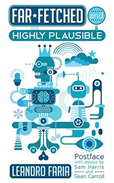
 |
The title of Faria’s techno-thriller becomes clear by its end in this fast-paced tale with a convoluted plot centered on the inherent risks of unregulated technological advances. The novel opens in the 1930s when the US Military Intelligence receives a summons via telegram from the renowned Nikola Tesla regarding an enigmatic invention “that will end all wars.” Faria leaves us with unresolved answers as the story jumps ahead almost ninety years to 2020. Here, we meet our protagonist, Nick Neville, a smart forensic accountant sent to audit a cutting-edge company developing an artificial intelligence called Cogvolve. Nick is hired by Blue Creek Capital over worries about its billion-dollar investment in the project. At first, nothing seems out of the ordinary to Nick until he starts to meet employees within the company and discovers unusual circumstances surrounding Cogvolve.
Michael Haas, the enigmatic CEO of Cogvolve, is well-known in the bioengineering field and “regarded as one of the brightest minds.” He recedes to the background for much of the novel until a surprise twist toward the end. Meanwhile, Frederico Lanza, lead researcher and co-founder of Cogvolve, is missing and later found dead. Missing along with Lanza is an encrypted flash drive which potentially contains highly sensitive information regarding Cogvolve. Nick receives some unexpected help from some eccentric friends: a 300-pound man associated with the Anti-Android Alliance with a particular fetish named Baby Kitty and a woman scientist named Liliana with connections to Lanza. A surprise ally, revealed later in the novel, also helps Nick. Yet everywhere Nick and his friends turn, danger seems to find them as they travel to Germany and the Arizona desert in search of the missing flash drive and answers to Lanza’s death. They encounter the Illuminati and the Federal Criminal Police Office of Germany, kidnapping, possible terrorist attacks, and clandestine goings-on—all connecting to Cogvolve. When they do find the answer they seek, it’s a chilling one in a twist toward the latter half of the novel. It ultimately ties everything together, including the connections to Nikola Tesla and even Leonardo Da Vinci.
Faria builds his man vs. machine thriller nicely with an intriguing premise that poses deep questions about our society’s ambitions and humanity. It is meticulously detailed, especially in the beginning where Faria delves into Nick’s work in forensic accounting, portraying Nick (who happens to like classic films) as a kind of private-eye detective that is reminiscent of someone like J.J. “Jake” Gittes in Chinatown. There is a small romance featured between Nick and a woman named Donna, but their relationship is hardly fleshed out enough to remember during the course of the intricate plot Faria sets forth. He does explore Nick’s past relationships a bit, giving us insight into Nick’s frame of mind in his relationship with Donna. And later on, Donna does help with her knowledge of Cogvolve, but she comes across more as a throwaway character. Baby Kitty, on the other hand, is one of the more engaging, complex, and humorous characters in Faria’s narrative, adding richer layers to the story where other characters lack.
Faria also juxtaposes the two key members of Cogvolve as a microcosm of humanity’s approach to the rise of artificial intelligence. As Donna reveals to Nick, behind Michael Haas’s smile is a “control freak,” while Lanza is a “true believer in the ability of artificial intelligence to help humanity transcend its limitations.” The reader, of course, decides who is really helping humanity, who is good and who is the villain, and gains some understanding of the dire consequences when we ignore the ramifications of our heedless desires. The author’s story looms towards the darker territory of Daniel H. Wilson’s Robopocalypse, with its explorations of computer intelligence out of control, and nods at Dan Brown’s The Da Vinci Code with its secret societies such as the Illuminati, whose members are willing to kill to protect its mysteries. Altogether, Faria’s novel is a fun read and lends itself well to the genre. Its overarching theme of the fear of technology taking over mankind threads everything together effectively in this absorbing tale of a few people working together to fight and save what humanity we might have left.